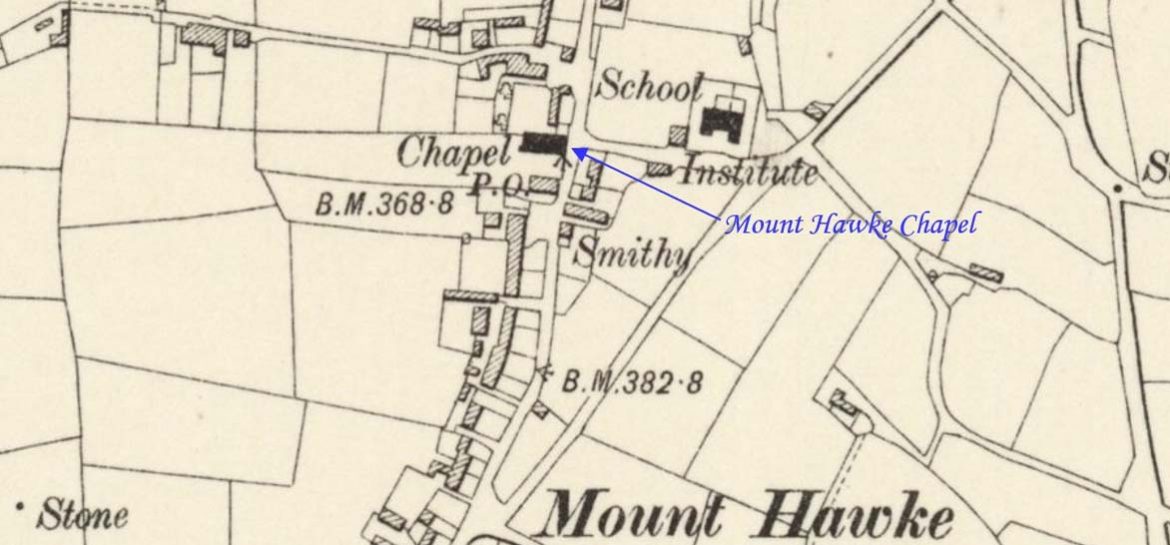
Mount Hawke is a village approximately eight miles west-northwest of Truro, five miles north-northeast of Redruth and two and a half miles south of St Agnes. This profile of Mount Hawke Wesleyan Chapel has been compiled by Clive Benney & Tony Mansell.
1817: Probable date Mount Hawke Wesleyan Society formed.
1820: Chapel built on a site described as, “… a piece of land five yards in extent purchased for the erection of a meeting house in Banns, at a place called Mount Hawke.” (The unit of measurement referred to is a Cornish unit, larger than English yards)
Built as a Wesleyan chapel. (SWChurches)
“A piece of land was purchased for £2 and the transfer was completed by the delivery of a Rod. The Trustees furthermore agreed to pay as rent the sum of two pence per annum. This annual charge was commuted by a cash payment in 1903. (The Mount Hawke Wesleyan Church centenary booklet produced in 1920)
Wesleyan chapel with schoolroom behind, possibly the original chapel, Chapel remodelled or rebuilt 1906. Was listed grade II but re-assessed as not a special example for the 1906 date of its external appearance and deleted from the statutory list 1999. Attractive stuccoed Italianate 2-window front gable end with moulded coping, quatrefoil to central gable, mid-floor string course and round hoodmoulds. Listed in Stell (b1). (Cornwall Heritage Gateway)
The author of the 1920 booklet is not identified but he, or she, goes on to say, “It may come as a shock to learn that all the arrangements preliminary to the erection of the chapel were made in a public house.” This was at a Court held at John Opie’s in Churchtown, St Agnes.
Miners were the First Trustees: “The names of the original trustees of the chapel in 1820 were William Tyack, William Martin, William George, Simon Wilkins, James James, Christopher Whitford, James Tonkin, Simon Reynolds, George Martin, John Richards, James Rosewall, Edward Nettall and Francis Harris. Of these 13 men, 11 were miners; one man a blacksmith and another a yeoman; mining was obviously the sole reason for the existence of the village. In 1831, four names were added – James Nicholls, Richard Richards, John Libby and William Harper.” (The Journal of the St Agnes Museum Trust No. 9)
“It is noteworthy that, despite the restricted educational facilities of that day, each, with one exception, was able to inscribe his name on the trust deeds in a good, legible style…” (The Mount Hawke Wesleyan Church centenary booklet produced in 1920)
Bond, Mount Hawke Wesleyan Chapel, St Agnes. Parties: 1) Captain William Thomas, Captain James James, James Nicholas, James Rosewall, William Blackney, John Phillips, Edward Willoughby, James Tonkin, Isaac Nicholas and Simon Reynolds, miners, James Martin, carpenter, William Harper, Francis Harris and John Libby, yeoman, all of St Agnes, Trustees for the Methodist Society at Mount Hawke. 2) William Martin, yeoman, of St Agnes. Bond in £100 to secure payment of £50 plus interest. (with note of repayments, 1842-1844) Part of bundle, MR/N/806 – 815, contents of an original bundle, ‘Mount Hawke Chapel Papers’. (Kresen Kernow 18 Feb 1841)
1861: The Mount Hawke Band of Hope tea treat of 1861 was clearly a large affair as it included two bands: Chacewater and St Day. There was the usual parade with their banners and, on this occasion, it ended up for tea in Mr Garland’s field. Ashley Rowe, writing in the “Journal of the St Agnes Museum Trust,” describes an even more elaborate affair the following year when the procession began at Mount Hawke and made its way to St Agnes, led by the Redruth and St Day Bands. From there they headed for Trevaunance Pier, a total distance of three miles! He wrote that they enjoyed their penny trips on the boats and returned to Mount Hawke for the tea and a band concert.
1864: An area of the field adjoining the Chapel was purchased for the sum of five shillings: this enabled a passage to be built at the south end of the Chapel, as a means of entry to the rear of the premises.
10 July 1870: Bond, Mount Hawke Wesleyan Chapel, St Agnes. Parties: 1) John Libby, Edward Willoughby, William Richards, John Tredinnick, Thomas Reynolds, John Nettle, James Nicholas, John Hawke, James Tredinnick, Thomas Rodda and John Nettle the younger, all of St Agnes, Trustees. 2) Catherine Goyne, of St Agnes. Bond in £80 to secure payment of £80 plus interest (endorsed with ‘£20 and interest being received on 24 Apr 1872, £60 on the principal sum outstanding’). Part of bundle, MR/N/806 – 815, contents of an original bundle, ‘ Mount Hawke Chapel Papers’. (Kresen Kernow MRN/809)
1877: “MOUNT HAWKE. Teetotal Excess. A correspondent writes: The congregation of Mount Hawke Wesleyan Chapel have been lately thrown into a state of excitement owing to one of their preachers having presumed to state his opinion on the parable of our Lord turning water into wine in a manner not at all satisfactory to the great teetotal portion of the congregation. Meetings have been held, the minister censured, and it is said none but teetotal sermons must be preached in future. A nice life anyone but a teetotaller must have with them. The minister is a talented preacher and much respected by the other portion of his congregation but must be thankful when his time is up. It is said that Mount Hawke is to be hedged in to keep out all intruders.” (Royal Cornwall Gazette – Friday 16 February 1877)
1882 – 6th March: Chapel registered for marriages.
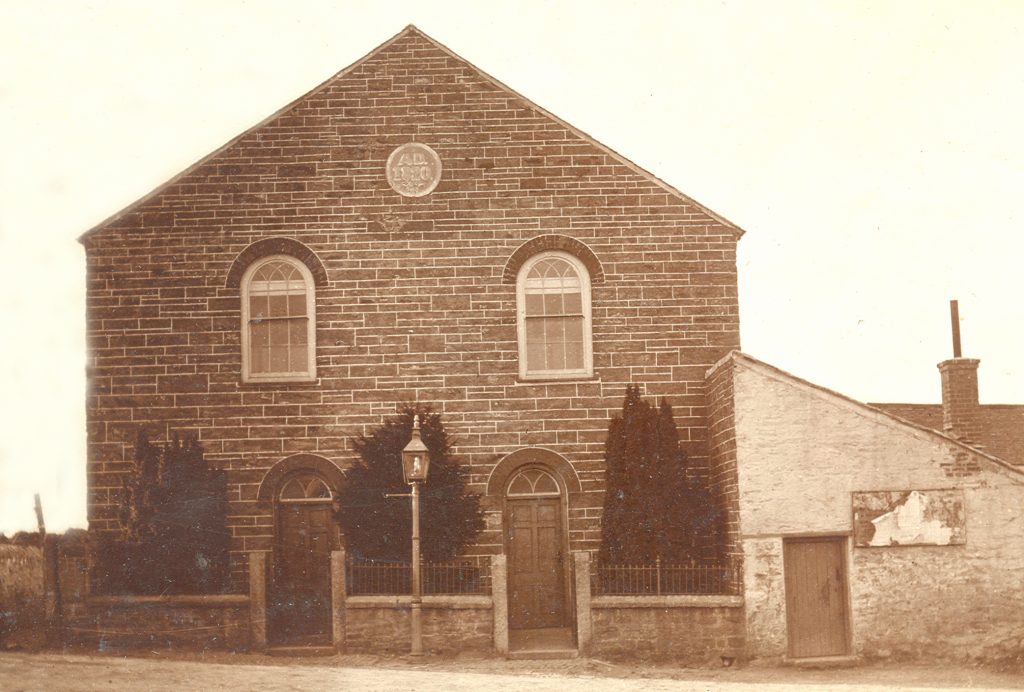 The original façade (Photo: courtesy Clive Benney)
The original façade (Photo: courtesy Clive Benney)
1885: New two-manual organ installed. (Royal Cornwall Gazette – Friday 26 June 1885)
1895: “The Rev. Harry Oxland, of Illogan, who was present with the Illogan Band at Mount Hawke, on the occasion of the annual Sunday school tea, was received with open hostility with some, and the treatment that he received from others was, to say the least of it, cold in the extreme. Little wonder then in leaving the village the Rev. gentleman shook the dust off his feet as a testimony against them.” (8 August 1895 – Royal Cornwall Gazette)
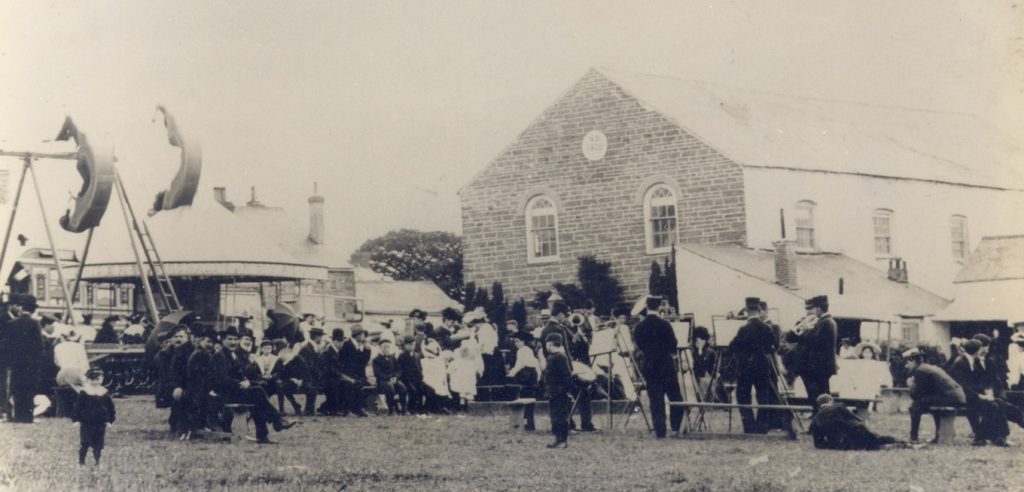 Circa 1903: The tea-treat complete with fairground attractions and brass band (Photo: courtesy Clive Benney)
Circa 1903: The tea-treat complete with fairground attractions and brass band (Photo: courtesy Clive Benney)
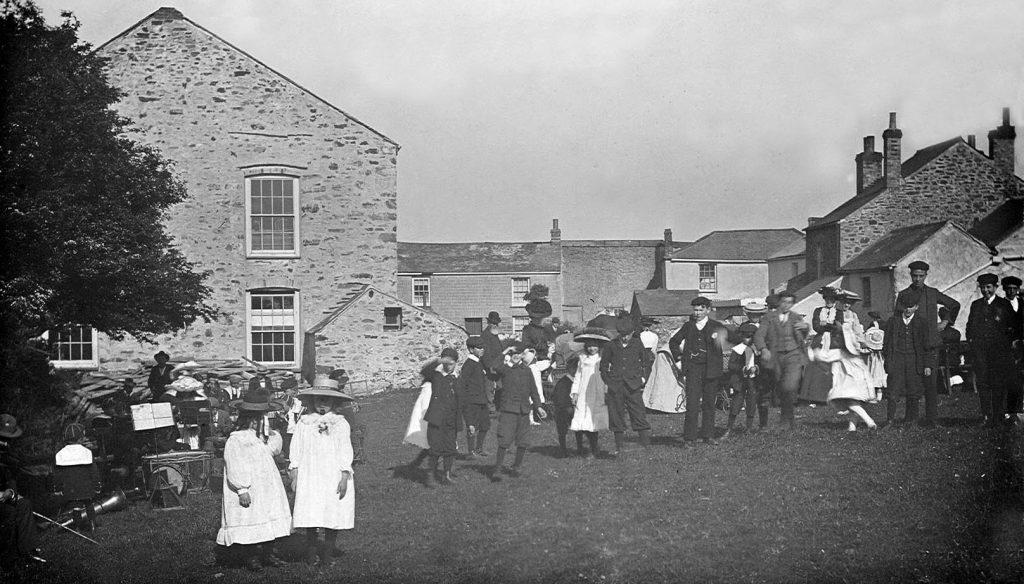 The rear elevation of the chapel and considering the presence of brass instruments, it is probably a tea treat (Photo: courtesy Clive Benney)
The rear elevation of the chapel and considering the presence of brass instruments, it is probably a tea treat (Photo: courtesy Clive Benney)
1903: There must have been hours of discussion on one particular matter. Despite promises to the contrary, Mount Hawke Wesleyans had decided to renovate their church rather than build a new one. It took several meetings to arrive at this decision and the parties were so evenly divided that it needed the casting vote of the chairman. (RCG 2/4/1903)
But then, in a remarkable about turn, it was to be a new chapel after all with the estimated cost at between £1,000 and £1,200. Plans were put in place to raise the money, but the first setback was the contribution from the 20th Century Fund which was to be only £100. There was to be further disappointment when it was discovered that the Connectional Chapel Committee would only provide a similar sum. (RCG August1903)
Raising sufficient funds was going to be a problem.
The scheme was back in the melting pot and because of the lack of sufficient funds, it was decided that Mount Hawke would not have its new chapel. Instead, the front façade would be re-built, the building renovated, and new seats installed.
At this time a new board of trustees was appointed: Henry Cocks, Edward Rodda, William Tonkin, John L Williams, Henry Tonkin, Francis Harris, John Goyne, Alfred Tremewan, William J Plummer, Peter Varker, James Tyack, William H Richards, Robert Nicholas, Baiton S Rickeard, Edgar Richards, R R Nancarrow, Arthur Goyne and Thomas Northcott.

July 1905: Specification of works, proposed renovation, Mount Hawke Wesleyan Chapel, St Agnes. Specification of works for proposed renovation of the chapel; Sampson Hill, architect, Redruth. Part of bundle, MR/N/806 – 815, contents of an original bundle, ‘ Mount Hawke Chapel Papers’. (Kresen Kernow MRN/812)
5 Aug-7 Sep 1905: Tenders, proposed renovation, Mount Hawke Wesleyan Chapel, St Agnes. Tenders, not accepted, received by the Trustees for proposed renovation works to chapel premises. Part of bundle, MR/N/806 – 815, contents of an original bundle, ‘ Mount Hawke Chapel Papers’. (Kresen Kernow MRN/814)
7 Sep 1905: Tender, proposed renovation, Mount Hawke Wesleyan Chapel, St Agnes. Tender, accepted, for proposed renovation works to chapel by William Henry Moyle of Chacewater, for £631. Part of bundle, MR/N/806 – 815, contents of an original bundle, ‘ Mount Hawke Chapel Papers’. (Kresen Kernow MRN/815/1)
1906: Mr Moyle of Chacewater undertook the work for a contract price of £700.
 Alteration work in progress (Photo: courtesy Clive Benney)l
Alteration work in progress (Photo: courtesy Clive Benney)l
The 1920 booklet informs us that the building was illuminated with the Litz gas system, the first chapel in Cornwall to use it. Low-pressure hot-water pipes were used to keep the place warm and there was a good two-manual organ, for which, it seems, there had always been an honorary Organist. The Society was almost free from debt.
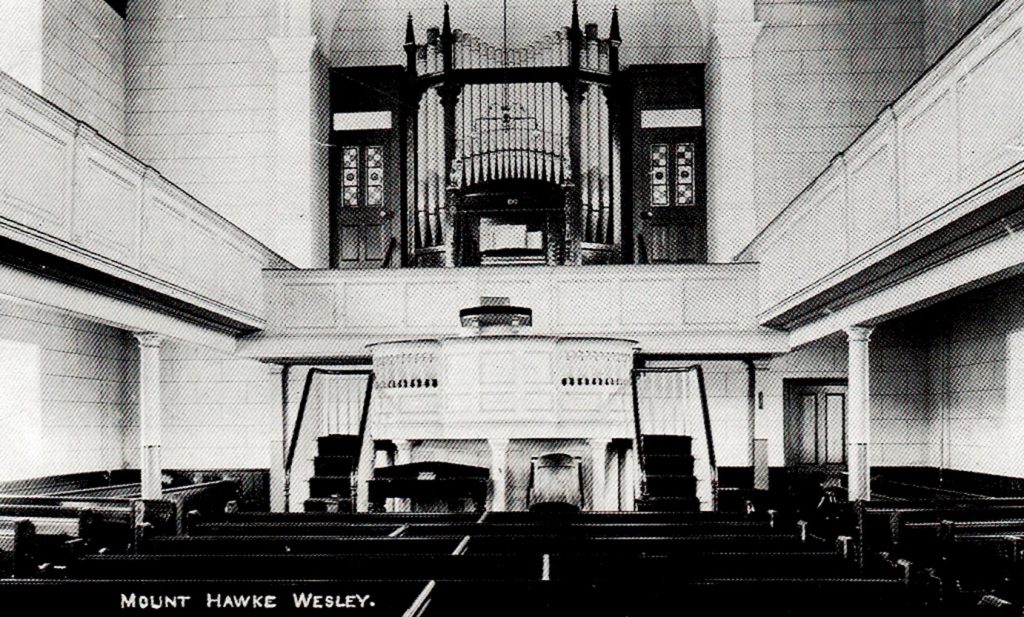 Circa 1910…The interior of the renovated chapel (Photo: courtesy Clive Benney)
Circa 1910…The interior of the renovated chapel (Photo: courtesy Clive Benney)
 (Photo: courtesy Clive Benney)
(Photo: courtesy Clive Benney)
John Kinsman, a Cornishman in London, wrote “The Cornish Handbook” circa 1920; it included his memories of the local event in his village of Mount Hawke. “Whitsuntide festival in Cornwall was when maidens and youths selected it as the season for the display of new clothes. Many villages held their ‘Tea Drinking’ on Whit-Monday. It was the time for lovers to walk together and to indicate their preferences to their neighbours. A ‘Tea Drinking’ is essentially a social function, enabling all who take part to dispense with the formalities which would keep them apart. First, a procession is formed, headed by a brass band and resplendent with banners and flags. After parading the village, it enters a field, lent for the occasion by a friendly farmer and men, women and children sit down to eat huge quantities of saffron cake and drink freshly made tea, the adults at long tables and the children on seats arranged to form a complete circle. Each child brings his or her own ‘Tea Drinking’ cup, which is emblazoned with some suitable motto; the tea is poured from huge earthenware pitchers, while saffron cakes are served from wide wicker baskets, each child receiving a whole cake. After tea, music and games fill the hours. The custom is so full of gladness that one hopes it may never be forgotten.”
1924: Mount Hawke Sunday School and vestry renovated. (Cornubian and Redruth Times – Thursday 25 September 1924)
Joy Stevenson looked back fondly of her early memories of tea treats which would have been sometime around 1930: “The first indication I had as a child that tea treat day was approaching was the arrival of Miss Pearce, a birdlike lady who travelled the area with a small case of personal belongings and her sewing machine. She lived as part of the family for a week, or however long it took to sew whatever garments the family needed. In our case it was new dresses for tea treat day. Can you imagine the excitement as we saw the material which mother had bought in Truro weeks before, transformed into dresses?
Some years there was a fancy-dress competition and Miss Pearce turned out costumes with the artistry of today’s dress designers. One year she made my Queen of Hearts costume, it was quite beautiful though I did not appreciate it at the time. You see, my sister had an Indian Squaw costume and was to walk with a boy dressed as an Indian Chief, they even had a tepee to carry, much more exciting than a Queen of Hearts. I screeched blue murder to be allowed to join them, but in those days children were kept firmly in their place and it was Queen of Hearts or nothing, as mother reminded us all, ‘Who do ee think iz goin stop their orse and cart to geek at you?’
The day usually started with a parade through the village behind a band, we did not boast one of our own so usually had the St Agnes Band to play for us. Of course, we always danced the Flora, I can never remember not being able to do it, as if we Cornish were born with the ability to dance it, and we did with gusto on tea treat day showing off to the people lining the route.”
1932: The Wesleyan, Primitive Methodist and the United Methodist Church amalgamated to become the Methodist Church of Great Britain.
1932: the chapel Became Mount Hawke Methodist Church. (SWChurches)
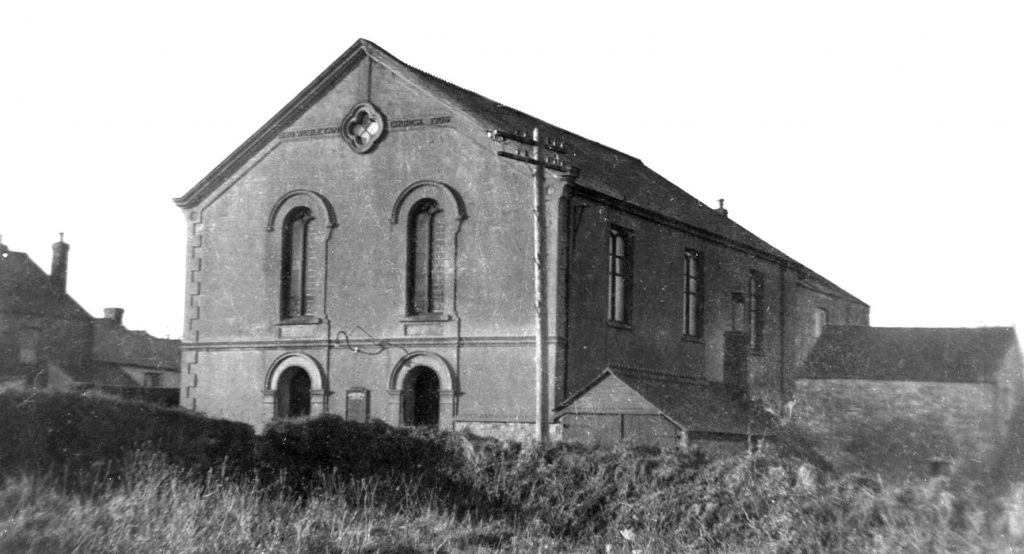 Circa 1945 taken from G A Carlyon’s yard (Photo: courtesy Clive Benney)
Circa 1945 taken from G A Carlyon’s yard (Photo: courtesy Clive Benney)
1957-1958: ‘The Chapel at Mount Hawke. Article from ‘Some Chapters in Cornwall’s History’, volume VI by Ashley Rowe. (Kresen Kernow ARC/25)
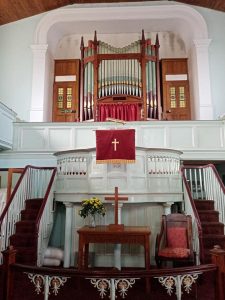 (Photo: David Philp)
(Photo: David Philp)
 Circa 1950…The chapel with its 1906 façade (Photo: courtesy Clive Benney)
Circa 1950…The chapel with its 1906 façade (Photo: courtesy Clive Benney)
1990: Following the renovation of the organ a service of re-dedication was held on the 28th March 1990.
2009: Schoolroom refurbished.

Is there any remaining odd pieces of Mount Hawk chapel China ( if there ever was any?)
Hi there
My name is Wendy Goyne from Australia … I visited a Miss Goyne from Mt Hawke in the 80’s .. at her house and she said she owned a caravan park … I was younger then and didn’t take it all in .. but only know that my grandfather Norman Goynes farther was James Goyne with connections with Saint Agnes Cornwall …Miss Goyne … showed me a bible and when she turned the front page it was John Goyne if Bendigo … my dad is John Goyne and his grandfather James lived in bendigo … they were all connected with mining … can you help in anyway ??
Longing to find my long lost relatives in Cornwall …. Thank you
Wendy Goyne Castlemaine Victoria Australia
Email : maher.wendy@hmail.com
My brother is visiting Cornwall in about 2 to three weeks time from Australia and would be amazing if you could find a connection
Many thanks
Wendy
Are you happy for me to display your message on Fb Wendy? Let me know on tonymansell4@outlook.com
My ancestor Ann Nicholls was baptized here in 1837. She had a few siblings born in Mount Hawke from 1812 was the Chapel around at that time ?
Hi Colin, bot this Wesleyan Chapel.
Thank you. I wondered if it would have been an older building.